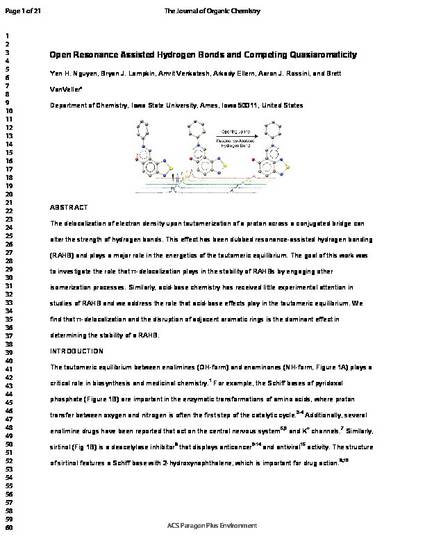
Article
Open Resonance Assisted Hydrogen Bonds and Competing Quasiaromaticity
The Journal of Organic Chemistry
Document Type
Article
Disciplines
Publication Version
Submitted Manuscript
Publication Date
7-19-2018
DOI
10.1021/acs.joc.8b01331
Abstract
The delocalization of electron density upon tautomerization of a proton across a conjugated bridge can alter the strength of hydrogen bonds. This effect has been dubbed resonance-assisted hydrogen bonding (RAHB) and plays a major role in the energetics of the tautomeric equilibrium. The goal of this work was to investigate the role that π-delocalization plays in the stability of RAHBs by engaging other isomerization processes. Similarly, acid-base chemistry has received little experimental attention in studies of RAHB and we address the role that acid-base effects play in the tautomeric equilibrium. We find that π-delocalization and the disruption of adjacent aromatic rings is the dominant effect in determining the stability of a RAHB.
Copyright Owner
American Chemical Society
Copyright Date
2018
Language
en
File Format
application/pdf
Citation Information
Yen H. Nguyen, Bryan J. Lampkin, Amrit Venkatesh, Arkady Ellern, et al.. "Open Resonance Assisted Hydrogen Bonds and Competing Quasiaromaticity" The Journal of Organic Chemistry (2018) Available at: http://works.bepress.com/aaron-rossini/40/

This is a manuscript of an article published as Nguyen, Yen H., Bryan J. Lampkin, Amrit Venkatesh, Arkady Ellern, Aaron J. Rossini, and Brett VanVeller. "Open Resonance Assisted Hydrogen Bonds and Competing Quasiaromaticity." The Journal of organic chemistry (2018). Posted with permission.